
Information and Orders: 1-406-259-9004
Hours: Mon - Sat 10-6 MST
Central Hobbies
1401 Central Avenue
Billings, MT 59102
We Gladly Accept:

as well as

PLASTIC MODELS : AIRPLANES / HELICOPTERS
Shipping cost will vary by dimensions
or weight please call or email for shipping quotes.
- Page 2 of 12 | 140 Total Products
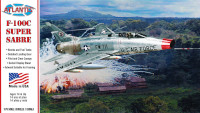
ATLANTIS 1/70 F-100C Super Sabre
Description:
1/70 Scale. Comes crisply molded in silver and clear with our famous clear swivel stand. From the classic Revell tooling. Brought back to its original form.
Complete with original decals and instructions.
Brand new Artwork.
Skill level 2.
Interesting facts about your F-100C Super Sabre The North American F-100 Super Sabre is an American supersonic jet fighter aircraft that served with the United States Air Force from 1954 to 1971 and with the Air National Guard until 1979. The first of the Century Series of USAF jet fighters, it was the first USAF fighter capable of supersonic speed in level flight, clocked at 822 miles per hour. The F‑100 was designed by North American Aviation as a higher-performance follow-on to the F-86 Sabre air-superiority fighter. The F-100C was powered by a Pratt and Whitney J-57 Turbo-jet engine with afterburner, and is rated in the 10,000 pound thrust class. It had a wingspan of 38 feet with the wings sweeping back at an angle of 45 degrees and an overall length of 47 feet. Its armament consists of 4 x 20mm cannons and its fire power can be further increased by the use of externally mounted rockets. Adapted as a fighter-bomber, the F-100 was superseded by the high-speed Republic F-105 Thunderchief for strike missions over North Vietnam. The F‑100 flew extensively over South Vietnam as the air force's primary close air-support jet until being replaced by the more efficient subsonic LTV A-7 Corsair II. The F‑100 also served in other NATO air forces and with other U.S. Allies. In its later life, it was often referred to as the "Hun", a shortened version of "one hundred". By 1972, the F-100 was mostly phased out of USAF active service. In foreign service, the Royal Danish Air Force and Turkish Air Force F-100s soldiered on until 1982. Many F-100's have survived and are on display in Air Museums across the globe.The Black Panther squadron insignia illustrated on your box cover and supplied on your decal sheet is the insignia used for the 21st day fighter squadron (active until 1959) which will add some authentic detail on your Atlantis model.

Our Price: $19.99
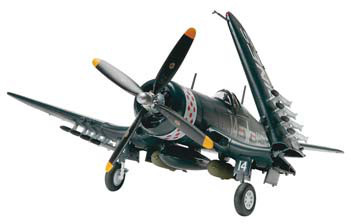
REVELL 1/48 Corsair F4U-4
Description:
This is a F4U-4 Corsair Plastic Model Kit from Revell. Suitable for Ages 10 & Older.
FEATURES:
Highly detailed plastic pieces molded in light gray and clear
Folding wings
Retractable landing gear and doors
Optional armament 3 external drop tanks, 2-1000 pound bombs and 8 under-wing rockets
Waterslide decals
Illustrated instructions
MARKING OPTIONS:
One decal sheet with markings for 2 versions:
1) F4U-4, VMA-332, USS Bairoko (CVE 115) Korea, July 1953
2) F4U-4, VMF-214, "Black Sheep" Squadron, USS Sicily (CVE-118) Korea, 1951
SPECS:
Scale: 1/48
Length: 8" (203mm)
Wingspan: 10-1/2" (267mm)
Skill level: 2
Parts: 70
Our Price: $19.95
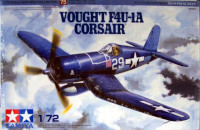
1:72 Tamiya Vought F4U-1A Corsair
Description:
Introduced into service in 1942, the Vought F4U-1 featured inverted gull wings and a massive 2,000hp engine spinning the largest propeller mounted on a fighter at the time. While the fighter?s performance and toughness was quite impressive, deficiencies such as inadequate forward visibility, restricted all-round visibility due to the early frame-like canopy, and the tendency for the left and right wings to stall at different speeds led to various improvements being added throughout production, eventually resulting in the F4U-1A version. These improvements included a longer tailwheel leg for better forward visibility, a new canopy for better all-round visibility, and an almost unnoticeable 15cm ?stall strip? fixed to the leading edge of the right wing to ensure both wings would stall at the same speed. = About the Model = * 1/72 scale assembly model kit of the Vought F4U-1A Corsair * Kit depicts a final F4U-1A Corsair production version with all improvements or versions at different stages of the improvement process. * Parts for 1000lb. bomb, external fuel tank, two types of propellers, and two types of tailwheel are included to provide many modelling possibilities * High quality decals for 3 different sets of markings
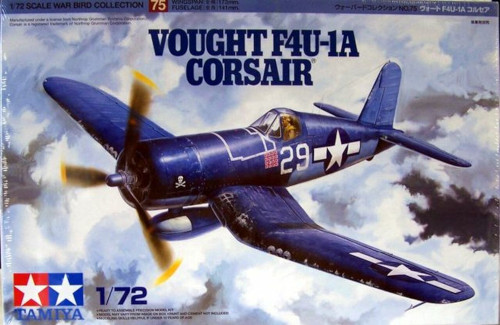
Our Price: $27.99
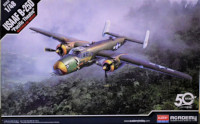
B-25D Pacific Theater USAAF
Description:
Our Price: $57.99
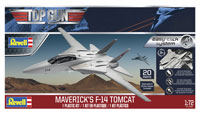
REVELL 1/72 Maverick's F/A-18 Hornet Easy-Click
Description:
An easy snap together model kit of the Hornet. In the film “Top Gun: Maverick”, the legendary Pete “Maverick” Mitchell who passes on his extraordinary flying skills to the new Top Gun generation, flies an F/A-18.
• Multi-part fuselage
• Display Stand
• Waterslide & Peal-N-Stick Stickers
Skill Level: 2
Scale: 1/72
Length: 8.78"
Wingspan: 6.50"
Parts: 14
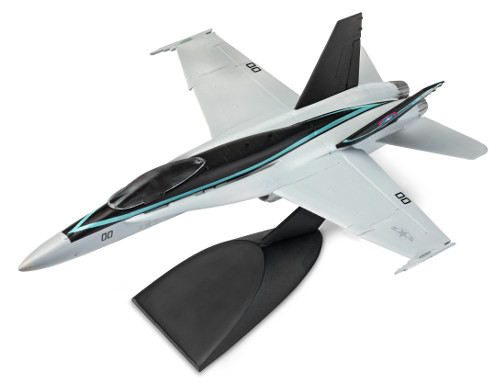
Our Price: $22.95
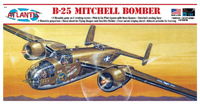
ATLANTIS MODELS 1/64 B-25 Mitchell Bomber Flying Dragon Plas
Description:
Can be built as Flying Dragon version or the Doolittle Raider. Optional parts and decals are included for both. Also comes with our Famous Clear swivel stand and art that is suitable for framing. 2 movable guns, 2 rotating turrets - Pilot & Co-Pilot figures and Nose Gunner - Landing gear with rolling wheels - 2 movable propellers - Colorful decal sheet - Clear swivel display stand
The North American Mitchell Bomber had a wingspan of 67' 7". Fuselage length was 52' 11". Normally during WWII this version of the B-25 carried four .50 cal. machine guns in two revolveing turrets and one in the nose. The Aircraft flown in the famous Doolittle raid had their lower turret removed. General James Doolittle, whose B-25 led a squadron on 25 other B-25'S on the first devastating raid on Tokyo from the USS Hornet Aircraft Carrier on April 18th, 1942. The crew consisted of 5 Airmen. This kit can be built for either version.

Our Price: $22.99

TAMIYA 1/48 Raiden Jack Kit
Description:
The J2M Raiden (Allied reporting name "Jack") was developed by the Japanese Navy in WWII as a land-based interceptor. It began to reach units from September 1944 and they were used to intercept B-29 bombers which were attacking Japan. This kit accurately depicts the J2M3 variant and allows modellers to assemble either deployed or retracted landing gear. Parts for a drop tank and two pilot figures, as well as three marking options, including a 302nd Kokutai aircraft, are included.

Our Price: $15.99
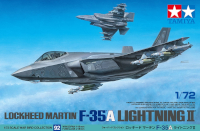
TAMIYA 1/72 Lockheed Martin F-35 A Lightning Ii
Description:
This model kit recreates the state-of-the-art F-35A Lightning II in 1/72 scale. It inherits many of the detailed features first seen in our 1/48 scale release. Thanks to extensive research, the A variant of the Lockheed Martin F-35 Lightning II is available to fans in either preferred scale.
About the F-35A
Fighter jets have continued to develop since they were first seen in late WWII, to the point where modern-day aircraft such as the F-35 Lightning II and F-22 Raptor are often called "fifth generation" fighters; qualities such as their highly advanced stealth characteristics and network connectivity set them apart from earlier fighters. Developed under the Joint Strike Fighter Program (JSF), the F-35 integrates multiple functions into its design and there are three types at the time of writing: the F-35A conventional take-off and landing (CTOL) aircraft, the F-35B short take-off, vertical landing (STOVL), and the F-35C, with its larger wing and tail; across these three variants, the F-35 can accomplish various missions without impacting upon its observability and exemplary maneuverability. Multiple sensors are at the heart of its advanced capabilities, and the wealth of data harvested is shared via multifunction advanced data link, helping provide the crew with outstanding information via a large cockpit display and the helmet-mounted display system. The F-35's maiden flight was in December 2006, and deployment with air arms in the U.S., Italy, Japan, and more is planned, as the aircraft appears set to take on a key role in the defense landscape in years to come.
• 1/72 scale plastic model assembly kit. Wingspan: 148mm, fuselage length: 218mm.
• Features refined molded depictions of radar absorbent material (RAM) sections on the surface.
• This kit can be assembled with one choice of the three ordnance patterns – stealth mode, air-to-air mode, and beast mode.
• Ordnance components can be attached to the weapons stations on the belly of the aircraft.
• (Weapons bay door can only be attached closed.)
• The fuselage with integrated wing has a realistic rendering of Blended Wing Body (BWB).
• This kit also features realistic renderings of the following sections:
- Y- shaped air intakes
- Cockpit and landing gear bays
- Engine nozzle (one-piece design)
- Martin-Baker US16E ejection seat
- RCS (radar cross section) enhancers affixed to top and bottom sections (two for each, four in total) during basic training exercises.
- Boxes stored in nose landing gear bay.
• Choose from open or closed canopy (not interchangeable after assembly).
• Flaps are assembled in the up position.
• Canopy and EOTS sensor fairing on nose undersurface are recreated in transparent plastic.
• Includes a realistically recreated seated pilot figure with Helmet-Mounted Display (HMD) and ordnance components (AIM-9X Sidewinder x2 and GBU-12 Paveway II x4).
• Comes with three marking options:
• 34th FS, 388th FW, U.S. Air Force Air Combat Command, Hill AFB, Utah
• 301st Fighter Squadron, 3rd Wing, Japan Air Self-Defense Force, Misawa Air Base 302nd Fighter Squadron, 3rd Wing, Japan Air Self-Defense Force, Misawa Air Base
• Includes masking stickers for painting demarcation of canopy and EOTS sensor fairing components, and a full-color painting guide.

Our Price: $45.99
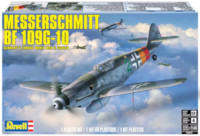
REVELL 1/48 Messerschmitt Bf 109G-10
Description:
The Bf 109 was first flown in 1935 and went on to become one of the most popular axis fighter planes in wartime aviation history. Towards the end of the 2nd World War, Bf 109 production reached in excess of 33,000 units. The G-10 variant was developed late in the war and had a larger 1,475 HP supercharged engine and heavier protective armor plating. Your Revell model has a movable propeller and long range fuel tank, a detailed cockpit, optional position landing gear and authentic G-10 decal markings for one Luftwaffe version.
- Movable propeller plus long range fuel tank.
- Detailed cockpit and optional position landing gear.
- Authentic markings for Bf 109G-10, IV./JG301, Stendal, Spring 1945.
- Molded in light gray and clear. (Paint and glue required, not included)
- Scale: 1:48
- Number of parts: 40
- Length: 7.50 in
- Wingspan: 8.125 in
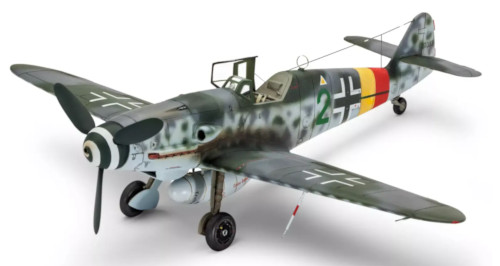
Our Price: $17.95
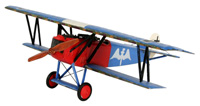
REVELL OF GERMANY 1:72 Fokker D VII
Description:
The Fokker D VII was by far the best German fighter of the First World War. It dominated the sky from January 1918. Power plant: 185 hp, 6 cyl. BMW III engine,max. speed: 200 km/h at 1000 m altitude.
Structurally detailed surfaces
Two MG's
Movable propellers
Transfers for one version (with lozenge markings): Fokker D VII, JaSta 11,1918 Oblt. Rudolph Berthold

Our Price: $5.39

TAMIYA US P-51D Mustang With 1/4 ton 4X4 Light Vehicle
Description:
This cost-effective model kit set includes Items 61040 (1/48 North American P-51D Mustang™ 8th Air Force) and 89755 (1/48 1/4-ton 4×4 Light Vehicle), plus two (standing and sitting) pilot figures and two 108-gallon drop tanks from Item 61089 (1/48 North American P-51D Mustang 8th AF Aces), with a special package and new instruction manual (painting guide) based upon Items 89755/61089.
Also comes with two (standing and sitting) pilot figures and two 108-gallon drop tanks from Item 61089.
About the North American P-51D Mustang™
• 1/48 scale plastic model assembly kit.
• Features realistic rendering of cockpit interior.
• Includes two types of parts to depict exhaust pipe and canopy sections.
• Choose between up or down flaps, and open or closed shutter at radiator rear.
• Comes with two 75-gallon drop tanks, one pilot figure and four marking options.
About the 1/4-ton 4x4 Light Vehicle
• 1/48 scale plastic model assembly kit.
• Includes decals to depict an Army vehicle.
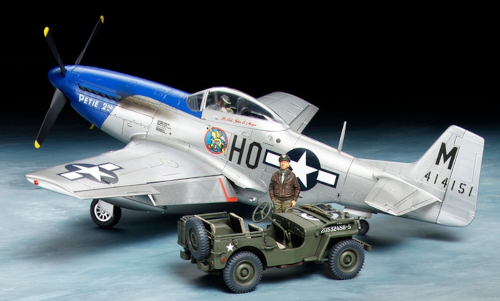
Our Price: $32.99
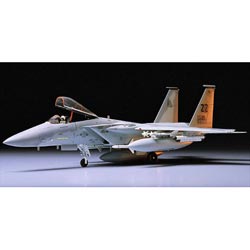
TAMIYA 1/48 McDonnell Douglas F15C Eagle
Description:
First deployed to units in 1979, the F-15C Eagle subsequently showcased its air superiority prowess during the 1991 Gulf War. This kit recreates this fighter complete with cockpit and radar details. The canopy may be assembled in either open or closed position and the intakes may be assembled in either full-up or down positions. Metal landing gear legs, ample ordnance, one pilot figure, and three marking options are also included.

All Plastic models are subject to Actual Shipping Cost due to size of box. Flat rate shipping does Not apply to Plastic Models.
Our Price: $40.49
- Page 2 of 12 | 140 Total Products